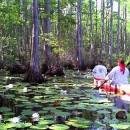What We Do
The National Wildlife Refuge System is a series of lands and waters owned and managed by the U.S. Fish and Wildlife Service. Wildlife conservation is at the heart of the refuge system. It drives everything we do from the purpose a refuge is established, to the recreational activities offered there, to the resource management tools we use. Selecting the right tools helps us ensure the survival of local plants and animals and helps fulfill the purpose of the refuge.
Horicon National Wildlife Refuge is managed primarily for migratory birds, which need a variety of habitats for feeding, courtship and nesting. Many other species benefit too. Management practices include manipulating water levels in 18 individual refuge impoundments, prescribed fire and invasive species invasive species
An invasive species is any plant or animal that has spread or been introduced into a new area where they are, or could, cause harm to the environment, economy, or human, animal, or plant health. Their unwelcome presence can destroy ecosystems and cost millions of dollars.
Learn more about invasive species control.
Management and Conservation
Refuges use a wide range of land management tools based on the best science available. Some refuges use prescribed fires to mimic natural fires that would have cleared old vegetation from the land helping native plants regenerate and local wildlife to thrive. Other refuges contain wilderness areas where land is largely managed in passively. The management tools used are aimed at ensuring a balanced conservation approach where both wildlife and people will benefit.
Our Services
Information on obtaining America the Beautiful passes and how to apply for a special use permit for commercial photography or other use on the refuge.
Law Enforcement
U.S. Fish and Wildlife Service law enforcement officers have a wide variety of duties and responsibilities. Officers help visitors understand and obey wildlife protection laws. They work closely with state and local government offices to enforce federal, state and refuge hunting regulations that protect migratory birds and other game species from illegal take and preserve legitimate hunting opportunities.
Laws and Regulations
Refuges are special places where wildlife comes first. All activities allowed on refuges must be evaluated to make sure each activity will not conflict with the reason the refuge was founded. The refuge system has special regulations about what you can do. You can find these regulations in the 50 Code of Federal Regulations - Subchapter C.


